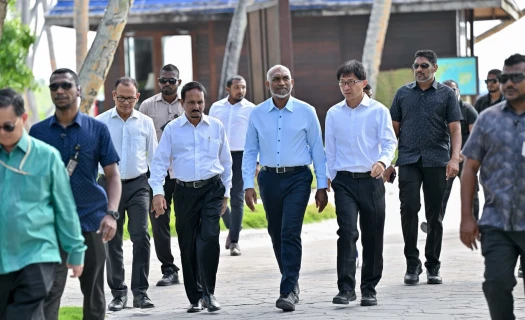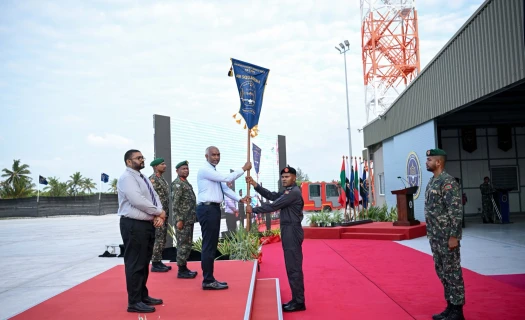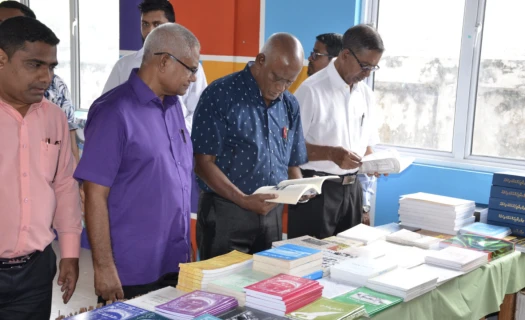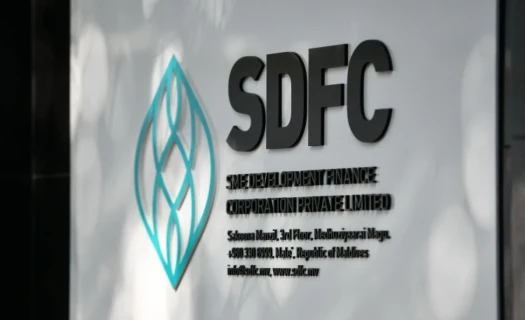Wed, 05 Nov 2025
|DHIVEHI
The changing face of Eid in the Maldives
01 Apr 2025
|

Photo: President's Office
Ask anyone about this year's Eid al-Fitr celebrations in the Maldives, and they will likely share stories of both cherished traditions and modern innovations. While urbanisation and technology have transformed how Maldivians celebrate Eid, Government-led initiatives ensured festivities that honoured cultural roots while embracing the future. Across the nation, communities created experiences showing that despite change, the true spirit of Eid endures.
The aroma of tradition
Not long ago, the scent of kulhi boakibaa (spicy tuna fish cake) baking in kitchens across the Maldives was the first indicator of Eid morning. That distinctive aroma stirred children from sleep, eager to prepare for prayers, knowing that upon their return, a warm slice awaited — paired with kalhu sai, the strong black tea that somehow tasted richer after 30 days of fasting.
"Hurry up and get ready," mothers would call out as the day began to unfold.
Eid breakfast was once a meal cherished across generations. Families gathered around tables laden with kulhi boakibaa (often called Eid boakibaa on this special day) alongside other hedhikaa (short eats).
In some islands, Eid kunbus (a caramelised coconut pudding) remained a treasured delicacy, requiring days of preparation and traditional slow cooking to develop its complex flavour.
Today, while many families still uphold these culinary traditions, others embrace more contemporary celebrations, such as ordering food for the whole family or visiting a nearby café for their morning dose of caffeine with friends.
Community spirit in prayer and giving
Throughout generations, Eid prayers have echoed across every inhabited island, followed by community feasts that complete the spiritual experience.
After prayers, people distribute Eid hadhiyaa (gifts) to children and adults alike. This year, children returned home with bags filled with presents or Eidi (money), reflecting the brotherhood that binds Maldivians together.
In the past, families prepared extra food for neighbours and those in need. Today, despite commercial interests introducing extravagant sales and luxury packages, many Maldivians still uphold the genuine generosity that defines the holiday.
Presidential traditions honoured
This year, following morning prayers, crowds gathered at Muleeaage to exchange Eid greetings with President Dr Mohamed Muizzu and First Lady Madam Sajidha Mohamed. The First Couple distributed gifts to visiting children and received citizens of all backgrounds with warmth and equality.
This display of inclusivity exemplified Eid's true spirit, one that even the youngest visitors could appreciate while reinforcing the importance of preserving cultural traditions amid changing times.
From extended families to modern gatherings
By mid-morning in years past, grandparents would be waiting — either in their own homes or, in earlier times, at the family dining table, ready to welcome the entire household. Extended families once lived under the same roof, making spontaneous gatherings a natural part of Eid.
In contrast, today, with families more scattered, visits to grandparents and relatives have become planned events. This transformation happened gradually as urbanisation spread and life grew busier. Families moved into high-rise apartments, where doors remained closed, and shared courtyards disappeared.
"Before, we would leave our doors open, and people would just walk in," recalls an elderly woman. "Now, we have to call first, or they might not even be home."
Now, many have embraced technology as the answer to distance. Video calls have become increasingly common on Eid, with children claiming the "convenience" of digital connection.
The sharing of Eid moments has similarly transformed. Where once families would recount their day's experiences over meals, now many instantly broadcast their celebrations through carefully composed photos or fleeting stories. These digital practices create a curious paradox — while technically more connected to distant relatives, many Maldivians find themselves physically present yet digitally distracted.
Yet many Maldivians are finding new ways to balance modern living with traditional connection, creating new traditions that preserve the essence of togetherness while adapting to contemporary realities.
"I appreciate seeing my grandchildren, even if it's through a phone," says one grandmother, "but nothing replaces their physical presence."
A festival for all ages
Even the way children experience Eid has changed. Instead of running from house to house as they once did, many now spend time engaged with technology. Yet this year's public celebrations provided communal experiences that screens cannot replace.
After Asr prayers, excitement built for the evening's festivities. Eid Haveeru 1446, organised by the Maldives National Defence Force (MNDF), Maldives Police Service (MPS), and several state-owned companies across Sultan Park, the Islamic Centre grounds, and Republic Square became the largest family gathering in recent Maldivian history.
Hundreds participated in various games and activities, with children's laughter filling the air. The President and First Lady joined in the celebrations, closely observing the joy around them. Activities like cutting the Eid cake brought everyone together before the evening concluded with entertainment.
Blending tradition with technology
As night descended, Majeedhee Magu in Malé transformed into a scene that harked back to the royal era. A choreographed reenactment of Hihchah Vadaigathun, a royal procession, bridged past and present, connecting younger generations with the country's rich heritage.
Meanwhile, crowds gathered at Central Park in Hulhumalé, where by 8:30 p.m., residents and expatriates watched a spectacular drone show light up the sky — a mesmerising display that captured Eid's essence through a fusion of tradition and innovation.
A celebration of lights
The illumination of Malé and islands across the atolls added to the festive atmosphere. Families sat on crescent-shaped benches bathed in soft light, while photos and videos captured the happiness that filled the air.
These dazzling lights are more than just a modern display; they mark a transformation in how the Maldives celebrates Eid. In the past, homes were decorated with carefully swept veli — white coral sand spread at doorsteps to show respect and welcome. Today, fairy lights, Eid banners, and Government-led initiatives such as Eid Ali have reshaped these traditions. The handcrafted welcome arches, Gidige, once the pride of community spaces, now compete with contemporary displays, blending the old with the new in a truly festive way.
A moment of national unity
In a country often divided by political tensions, this Eid stood out as a rare moment of collective joy. The festivities proceeded without disruption, bringing together people from all walks of life.
Eid's future in the Maldives depends on the choices people make. While urbanisation, commercialisation, and digitalisation have altered traditions, they need not erase them. This year's celebrations proved that communities could choose connection over convenience, finding ways to keep the true spirit of Eid alive.


Popular News







